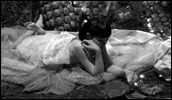The Primitchibu World
- Year
- 2009
- Original title
- Purimichibu na Sekai
- Japanese title
- プリミ恥部な世界
- Director
- Cast
- Running time
- 70 minutes
- Published
- 28 February 2010



by Tom Mes
The first scene of Kasumi Hiraoka's first feature-length film starts with the heroine standing at a storefront covered with rusty metal shutters, the name 'Dream Center' written above it in katakana. This image sums up the world of this yet little-known but fascinating filmmaker from Osaka, who has been making short films on 8mm and DV for about a decade. Her work is all about summoning forth the hidden dreams from everyday reality, something she achieves by rearranging, adding touches of vibrant colours, and through playacting in the most unexpected of places.
The Primitchibu World is not so much a narrative film as a performance and mood piece, inspired and driven by the music of singer-songwriter, performer, and essayist Takeshi Shirai, a.k.a. Primitchibu (the moniker is a play on words on 'primitive' and the Japanese for 'private parts'). There is a premise: a girl who sells flowers to passersby in the streets meets a boy who believes that war will break out if he traverses a shopping arcade and emerges at the other end.
Together this childlike couple dance in the streets, search for places where reality cannot penetrate, and meet a motley variety of eccentrics and colourful characters who share their peculiar view of life on earth. Dialogue is less about exposition than it exists as sounds and rhythm for their own sake, recalling the recent films of Seijun Suzuki. Combined with the ever-present music, it makes the whole move briskly along - hopping, dancing, running and skipping, rarely standing still. There is never a dull moment, also thanks to an incredibly vibrant colour scheme that is reminiscent of Teruo Ishii's work of the late 1960s.
Seijun Suzuki and Teruo Ishii are not the only illustrious stylists of Japan's cinematic past that are channeled in Hiraoka's work. Her previous film, the 28-minute Red Light District Graffiti (Rakugaki Iromachi, 2008), was quite overtly influenced by Shuji Terayama in its portrayal of a troupe of cheerful prostitutes in the old side-streets of Osaka. The Primitchibu World, in its full, unexpurgated form, takes the Terayama influence a step further by having its cast and musicians perform on stage as part of the theatrical experience while the film screens. Needless to say, this full-live version is a rare treat that will be prohibitively expensive to put on during foreign showings.
Kasumi Hiraoka's sensibilities stem from being not purely a cinephile. If performance and playacting play such a large part in her work, this is because in addition to her filmmaking, Hiraoka is also a pianist, drummer, and pole dancer (as a dancer she often forms part of the stage show of Japanese stoner rockers Acid Mother's Temple), as well as something of an amateur anthropologist: her films form chronicles of a disappearing Japan, not unlike Kiyoshi Kurosawa's penchant for capturing dilapidated architecture. However, since her terrain of choice is Osaka, the result feels more concentrated, denser in this respect than Kurosawa's work. Hiraoka truly is a chronicler of Japan's second city, its neighbourhoods and buildings: here it is the typical shopping arcades and the fading tradition of the fantasy love hotel at which she aims her camera. Just to illustrate the urgency: some of the locations she used in Red Light District Graffiti have already fallen victim to redevelopment. Osaka too is in the grip of developers eager to see the world transformed into a single giant shopping mall.
But there is no city without its inhabitants. Hiraoka gathers merchants, street musicians, kamishibai (paper theatre) performers, carefree youth, and even hapless passersby, who form a colourful procession of very local - dialect and all - colour. The intermissions and cutaways to performers recall the very pleasant digressions in Takashi Miike's work or the early films of Sogo Ishii, that were also populated by misfits musical and otherwise.
Without doubt the most memorable quality of Hiraoka's work is the director's visual sense: her feeling for colour and composition, for juxtapositions and framing. It doesn't seem to matter whether she uses existing locations or elaborate-looking set designs - the result is a world all of its own. The world of Kasumi Hiraoka. A world waiting to be explored.